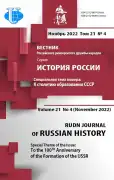Лагерная система в Прикаспийском регионе Казахстана в 1932-1940 гг.
- Авторы: Иванова Г.М.1
-
Учреждения:
- Институт российской истории Российской академии наук
- Выпуск: Том 21, № 4 (2022): К 100-летию образования СССР
- Страницы: 498-508
- Раздел: К 100‐ЛЕТИЮ ОБРАЗОВАНИЯ СССР
- URL: https://journal-vniispk.ru/2312-8674/article/view/321970
- DOI: https://doi.org/10.22363/2312-8674-2022-21-4-498-508
- ID: 321970
Цитировать
Полный текст
Аннотация
В изучении истории возникновения и деятельности советских лагерей до настоящего времени имеются серьезные лакуны, включая историю создания и функционирования лагерной системы в Прикаспийском регионе. Данное исследование восполняет пробел, существующий в историографии, и дает ответы на актуальные вопросы о локации отдельных лагерных подразделений, причинах, целях, задачах и условиях создания и функционирования лагерно-производственного комплекса в Казахстанском секторе Каспия. Основу источниковой базы составляют документы из фонда Главного управления мест заключения МВД СССР Государственного архива Российской Федерации. Показано, что с середины 1932 г. Главное управление исправительно-трудовых лагерей Объединенного государственного политического управления (ГУЛАГ ОГПУ) начало интенсивно развивать рыбную отрасль хозяйства с целью создания собственной базы снабжения. ГУЛАГ получил для использования новый рыбопромысловый район - Прорвинский, расположенный в северо-восточной части Каспийского моря. Для лова и обработки рыбы был создан Прорвинский исправительно-трудовой лагерь, который дислоцировался на острове Прорва в Каспийском море, функционировал с 1932 по 1940 г. и первоначально подчинялся ГУЛАГу ОГПУ. Одним из наиболее крупных подразделений было Гурьевское лагерное отделение с числом заключенных до 2 тыс. человек. Установлено, что создание рыбопромышленного лагерного комплекса на берегах Северного Каспия позволило значительно улучшить снабжение рыбной продукцией всего лагерного населения в СССР. Изучение дислокации рыболовецких лагерей и анализ их производственной деятельности показали, что в целом лагерная система в Прикаспийском регионе Казахстана не получила широкого распространения.
Ключевые слова
Об авторах
Галина Михайловна Иванова
Институт российской истории Российской академии наук
Автор, ответственный за переписку.
Email: iriran@mail.ru
ORCID iD: 0000-0002-3784-5619
д-р истор. наук, главный научный сотрудник Центра социальной истории России
117292, Россия, Москва, ул. Дмитрия Ульянова, 19Список литературы
- Akhmetova, U.T., Mukhtar, A.K. “From the history of the labor correctional camp Prorva (1932-1950).” II Study of the native land: its importance and priorities: Proceedings of the Republican online scientific-practical conference (May 15, 2020). Atyrau-Saraishyk: [N.s.], 2020 (in Kazakh)
- Akhmetova, U.T., Zhumabaev, A.Zh. “Prorva camp in the Gulag system (1932-1950).” Bulletin of WKSU, no. 3 (2020): 138-146 (in Kazakh). https://doi.org/10.37238/1680-0761.2020.79(3).14
- Bacon, Ed. The Gulag at War: Stalin’s Forced Labour System in the Light of the Archives. New York: New York University Press, 1994
- Bolonina, L.V. “Creation of the Prorvinsky forced labor camp in the Astrakhan region and its production and economic activities.” In Crossroads of history. Actual problems of historical science: Proceedings of the XII International Scientific and Practical Conference, Astrakhan, April 29, 2016, 76-79. Astrakhan: Individual entrepreneur Sorokin Roman Vasilievich, 2016 (in Russian)
- Chernavin, V.V. Notes of the “wrecker”. Escape from the Gulag. St. Petersburg: Canon Publ., 1999 (in Russian).
- David-Fox, M., ed. The Soviet Gulag: Evidence, Interpretation, and Comparison. University of Pittsburgh Press, 2016.
- Gvozdkova, L.I. History of repressions and Stalin's camps in Kuzbass. Kemerovo: Kuzbassvuzizdat Publ., 1997 (in Russian).
- Ivanova, G.M. GULAG in the system of a totalitarian state. Moscow: MONF Publ., 1997 (in Russian).
- Ivanova, G.M. The history of the GULAG: 1918-1958. Moscow: Politicheskaya Entsyklopedia Publ., 2015 (in Russian).
- James, R. Harris. “The Growth of the Gulag: Forced Labor in the Urals Region, 1921-1931.” The Russian Review 56, no. 2 (1997): 265-280.
- Kokurin, A.I., Petrov, N.V. “GULAG: structure and personnel.” Free thought, no. 8 (1999): 109-126 (in Russian).
- Korelskiy, V.P. In my time: Memories, traditions of the family, reflections. Arkhangelsk: Pravda Severa Publ., 1996 (in Russian).
- Morozov, N.A. GULAG in the Komi region. 1929-1956. Syktyvkar: Komi book Publishing House, 1997 (in Russian).
- Tanasiychuk, V.N. “The road to Dzhurun and back.” Star, no. 11 (1998): 202-214 (in Russian).
- Tanasiychuk, V.S. “Arrests at the Murmansk biological station in 1933.” Repressed Science. Issue 2, 306-318. St. Petersburg: Nauka Publ., 1994 (in Russian).
- Udovenko, I.V. “The camp system of places of detention in the Moscow region (1918 - the end of the 1930s).” In History of Russia from ancient times to the 21st century: problems, discussions, new views, 204-211. Moscow: Institute of Russian History RAS, 2018 (in Russian)
Дополнительные файлы









